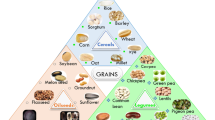Abstract
Producing good-quality, fine rice flour is more difficult than wheat flour because the rice grain is harder. The non-glutinous Japonica-type variety Seolgaeng, derived from N-methyl-N-nitrosourea (MNU) mutagenesis, and four other varieties, representing a range of amylose contents, were evaluated in this study. Dry-milled Seolgaeng rice flour exhibited an average particle size that is <70 μm, a more uniform particle-size proportion than other varieties. Moreover, we noted significant differences in the damaged starch content in flour from Seolgaeng compared to the other varieties (p<0.05). Seolgaeng flour showed a round starch structure, which would lead to better friability, finer particle size, and less damage to the endosperm during dry milling. Indeed, among all varieties evaluated in this study, dry-milled Seolgaeng flour had the finest particle size (averaging <70 μm) and exhibited less damaged starch. With its round starch granules, Seolgaeng is a suitable candidate for drymilled rice flour.
Similar content being viewed by others
References
Choi HC. Current status and perspectives in varietal improvement of rice cultivars for high-quality and value added products. Korean J. Crop Sci. 47: 15–32 (2002)
Tamaki M, Itani T, Suetsugu M. Relationship between the starch properties of white-core tissue and polishing characteristics in brewers' rice kernels. Plant Prod. Sci. 12: 233–236 (2009)
Hong HC, Moon HP, Choi HC, Hwang HG, Kim YG, Kim HY, Yea JD, Shin YS, Kang KH, Choi YH, Cho YC. New cultivar developed: A lodging tolerant, opaque rice cultivar “Seolgaeng”. Korean J. Breed. Sci. 43: 532–537 (2011)
Hong HC, Choi HC, Hwang HG, Kim YG, Moon HP, Kim HY, Yea JD, Shin YS, Choi YH, Cho YC, Baek MK, Lee JH, Yang CI, Jeong KH, Ahn SN, Yang SJ. A lodgingtolerance and dull rice cultivar 'Baegjinju'. Korean J. Breed. Sci. 44: 51–56 (2012)
Hong HC, Kim YG, Choi YH, Yang SJ, Lee KS, Lee JH, Jung OY, Yang CI, Cho YC, Choi IS, Baek MK, Kim MK, Yea JD, Hwang HG, Roh JH, Kim SL, Choi HC, Lee YT, Lee SH. A medium-maturing, giant-embryo, and germination brown rice cultivar 'Keunnun'. Korean J. Breed. Sci. 44: 160–164 (2012)
Ashida K. Properties of floury rice mutant and its utilization for rice flour. JARQ-Jpn. Agr. Res. Q. 48: 51–56 (2014)
Chiang PY, Yeh AI. Effect of soaking on wet-milling of rice. J. Cereal Sci. 35: 85–94 (2002)
Yeh AI. Preparation and application of rice flour (Rice chemistry and technology). American Association of Cereal Chemists, St. Paul, MN, USA. pp. 495–539 (2004)
AACC. Approved methods of the AACC, 10th ed. Method 44-15, Method 76-
American Association of Cereal Chemists, St. Paul, MN, USA (2000)
Juliano BO. Polysaccharide, proteins, and lipids of rice (Rice chemistry and technology). American Association of Cereal Chemists, St. Paul, MN, USA. pp. 59–120 (1985)
Hanashiro L, Abe JI, Hizukuri S. A periodic distribution of the chain length of amylopectin as revealed by high-performance anion-exchange chromatography. Carbohyd. Res. 283: 151–159 (1996)
Zhou Z, Robards K, Helliwell S, Blanchard C. Composition and functional properties of rice. Int. J. Food Sci. Tech. 37: 849–868 (2002)
Patindol JA, Gonzalez BC, Wang YJ, McClung AM. Starch fine structure and physicochemical properties of specialty rice for canning. J. Cereal Sci. 45: 209–218 (2007)
Kim KS, Lee JH, Chin JH, Koh HJ, Kim BK, Kim DG, Lee GL, Seo JH, Choi IY, Choi BS, Yang TJ. Defining the genome structure of ‘Tongil’ rice, an important cultivar in the Korean “Green Revolution”. Rice J. 7: 22–30 (2014)
Lisle AJ, Martin M, Fitzgerald MA. Chalky and translucent rice grains differ in starch composition and structure and cooking properties. Cereal Chem. 77: 627–632 (2000)
Kang HG, Park S, Matsuoka M, An G. White-core endosperm floury endosperm-4 in rice is generated by knockout mutations in the C-type pyruvate orthophosphate dikinase gene (OsPPDKB). Plant J. 42: 901–911 (2005)
Kaushik RP, Khush GS. Endosperm mutants in rice: Gene expression in japonica and indica backgrounds. Cereal Chem. 68: 487–491 (1991)
Zhu LJ, Liu QQ, Wilson JD, Gu MH, Shi YC. Digestibility and physicochemical properties of rice (Oryza sativa L.) flours and starches differing in amylose content. Carbohyd. Polym. 86: 1751–1759 (2011)
Zeng J, Li G, Gao H, Ru Z. Comparison of A and B starch granules from three wheat varieties molecules. Molecules 16: 10570–10591 (2011)
Ikeda TM, Ohnishi N, Nagamine T, Oda S, Hisatomi T, Yano H. Identification of new puroindoline genotypes and their relationship to flour texture among wheat cultivars. J. Cereal Sci. 41: 1–6 (2005)
Brites CM, Lourenco-dos Santos CA, Bagulho AS, Beiraoda-Costa ML. Effect of wheat puroindoline alleles on functional properties of starch. Eur. Food Res. Technol. 226: 1205–1212 (2008)
Yoon MR, Chun AR, Oh SK, Ko SH, Kim DJ, Hong HC, Choi IS, Lee JH. Physicochemical properties of endosperm starch and bread making quality of rice cultivars. Korean J. Crop. Sci. 56: 219–225 (2011)
Nishita KD, Bean MM. Grinding methods: Their impact on rice flour properties. Cereal Chem. 59: 46–49 (1982)
Sharma P, Chakkaravarthi A, Singh V, Subramanian R. Grinding characteristics and batter quality of rice in different wet grinding systems. J. Food Eng. 88: 499–506 (2008)
Mo YJ, Jeung JU, Shin YS, Park CS, Kang KH, Kim BK. Agronomic and genetic analysis of Suweon 542, a rice floury mutant line suitable for dry milling. Rice J. 6: 37–48 (2013)
Hayakawa T, Seo SW, Igaue I. Electron microscopic observation of rice grain: Part I. Morphology of rice starch. J. Appl. Glycosci. 27: 173–179 (1980)
Author information
Authors and Affiliations
Corresponding author
Rights and permissions
About this article
Cite this article
Kwak, J., Yoon, MR., Lee, JS. et al. Morphological and starch characteristics of the Japonica rice mutant variety Seolgaeng for dry-milled flour. Food Sci Biotechnol 26, 43–48 (2017). https://doi.org/10.1007/s10068-017-0006-5
Received:
Revised:
Accepted:
Published:
Issue Date:
DOI: https://doi.org/10.1007/s10068-017-0006-5




